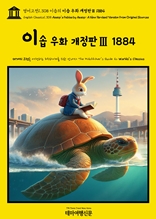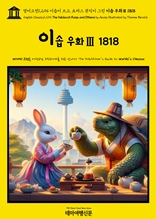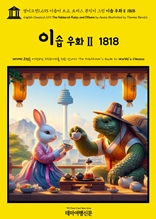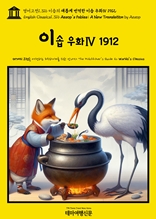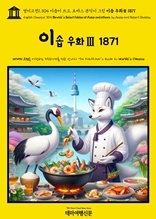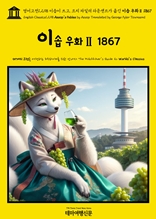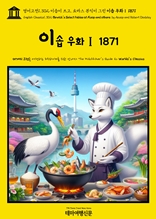영어고전1,308 이솝의 이솝 우화 개정판Ⅲ 1884(English Classics1,308 AESOP's Fables by AESOP: A New Revised Version From Original Sources)
도서정보 : 이솝(Aesop, B.C.620~B.C.564) | 2024-03-31 | EPUB파일
지원기기 : PC / Android / iOS
▶ 이솝의 이솝 우화 개정판 1884(AESOP's Fables by AESOP: A New Revised Version From Original Sources) : 이솝 우화는 최초로 그리스어(Greek)로 작성되었으며, 이후 라틴어를 비롯한 다양한 유럽언어와 전 세계의 언어로 번역되면서 ‘인류의 우화집’으로 사랑받고 있습니다. 이에 따라 이솝 우화집은 수많은 시대와 언어, 편집자, 삽화가에 따라 수백, 아니 수천 종으로 발간되었을 정도로 수많은 판본을 자랑합니다. 이솝 우화집은 때로는 저명한 편집자의 판본으로, 때로는 당대 유명삽화가의 버전으로 지금 이 순간에도 세계 각지의 독자들의 손에 들려 있습니다. 테마여행신문 TTN Korea은 이솝의 이솝 우화 개정판 1884(AESOP's Fables by AESOP: A New Revised Version From Original Sources)에 수록된 239편의 이솝 우화를 4권으로 분권하여, 소개해 드립니다. 테마여행신문 TTN Korea 영어고전(English Classics) 1,999선과 함께 어제도, 오늘도, 내일도 멋진 문학여행을!
▶ LIFE OF ÆSOP. The Life and History of Æsop is involved, like that of Homer, the most famous of Greek poets, in much obscurity. Sardis, the capital of Lydia; Samos, a Greek island; Mesembria, an ancient colony in Thrace; and Cotiæum, the chief city of a province of Phrygia, contend for the distinction of being the birthplace of Æsop. Although the honor thus claimed cannot be definitely assigned to any one of these places, yet there are a few incidents now generally accepted by scholars as established facts, relating to the birth, life, and death of Æsop. He is, by an almost universal consent, allowed to have been born about the year 620 b.c., and to have been by birth a slave. He was owned by two masters in succession, both inhabitants of Samos, Xanthus and Jadmon, the latter of whom gave him his liberty as a reward for his learning and wit.
▷ 이솝의 생애. 이솝의 삶과 역사는 그리스 시인 중 가장 유명한 호머의 삶과 마찬가지로 베일에 싸여 있습니다. 리디아의 수도 사르디스, 그리스 섬 사모스, 트라키아의 고대 식민지였던 메셈브리아, 프리기아 지방의 주요 도시인 코티움 등이 이솝의 출생지라고 주장하며 서로 다투고 있습니다. 이렇게 주장된 영예를 어느 한 곳에 확실히 부여할 수는 없지만, 현재 학자들이 이솝의 출생, 생애, 죽음과 관련하여 확립된 사실로 받아들이는 몇 가지 사건이 있습니다. 거의 보편적인 동의에 따라 그는 기원전 620년경에 태어났으며, 태어날 때부터 노예로 태어났다는 것이 인정되고 있습니다. 그는 사모스의 주민인 잔투스와 자드몬이라는 두 주인의 소유였는데, 후자는 그의 학문과 재치에 대한 보상으로 그에게 자유를 주었습니다.
▶ These few facts are all that can be relied on with any degree of certainty, in reference to the birth, life, and death of Æsop. They were first brought to light, after a patient search and diligent perusal of ancient authors, by a Frenchman, M. Claude Gaspard Bachet de Mezeriac, who declined the honor of being tutor to Louis XIII. of France, from his desire to devote himself exclusively to literature. He published his life of Æsop, Anno Domini 1632. The later investigations of a host of English and German scholars have added very little to the facts given by M. Mezeriac. The substantial truth of his statements has been confirmed by later criticism and inquiry.
▷ 이솝의 탄생, 삶, 죽음과 관련하여 어느 정도 확실하게 믿을 수 있는 것은 이 몇 가지 사실뿐입니다. 이솝의 생애는 프랑스인 클로드 가스파르 바셰 드 메제리악이 문학에만 전념하고 싶어 프랑스 루이 13세의 가정교사라는 영예를 거절하고 인내심을 가지고 고대 저서를 꼼꼼히 읽은 끝에 처음 밝혀졌습니다. 그는 1632년 “이솝의 생애”를 출간했습니다. 이후 수많은 영국과 독일 학자들의 조사는 메제리악이 말한 사실에 거의 추가되지 않았습니다. 그의 진술의 실질적인 진실은 후대의 비판과 조사를 통해 확인되었습니다.
▶ It remains to state, that prior to this publication of M. Mezeriac, the life of Æsop was from the pen of Maximus Planudes, a monk of Constantinople, who was sent on an embassy to Venice by the Byzantine Emperor Andronicus the elder, and who wrote in the early part of the fourteenth century. His life was prefixed to all the early editions of these fables, and was republished as late as 1727 by Archdeacon Croxall as the introduction to his edition of Æsop. This life by Planudes contains, however, so small an amount of truth, and is so full of absurd pictures of the grotesque deformity of Æsop, of wondrous apocryphal stories, of lying legends, and gross anachronisms, that it is now universally condemned as false, puerile, and unauthentic. It is given up in the present day, by general consent, as unworthy of the slightest credit.
▷ M. 메제리악(M. Mezeriac)이 이 우화를 출판하기 전에는 콘스탄티노플의 수도사 막시무스 플라누데스가 14세기 초에 비잔틴 황제 안드로니쿠스가 베니스에 파견한 사절단으로 파견되어 쓴 이솝의 생애를 펜으로 썼던 것이 남아 있습니다. 그의 생애는 이 우화의 모든 초기 판본에 서문으로 실렸으며, 1727년 크록솔 대주교(Archdeacon Croxall)에 의해 이솝 우화 판의 서문으로 다시 출판되었습니다. 그러나 플라누데스의 이솝우화에는 진실이 너무 적고 이솝의 기괴한 기형, 기이한 외경 이야기, 거짓 전설, 심각한 시대착오에 대한 터무니없는 그림으로 가득 차 있어서 지금은 거짓이고, 유치하며, 진실하지 않다고 보편적으로 비난받고 있습니다. 오늘날에는 일반적인 합의에 따라 조금도 인정할 가치가 없는 것으로 간주되고 있습니다.
구매가격 : 9,900 원
영어고전1,294 이솝이 쓰고, 토마스 뷰익이 그린 이솝 우화Ⅲ 1818(English Classics1,294 The Fables of Æsop, and Others by Aesop Illustrated by Thomas Bewick)
도서정보 : 이솝(Aesop, B.C.620~B.C.564) | 2024-03-31 | EPUB파일
지원기기 : PC / Android / iOS
▶ 이솝이 쓰고, 토마스 뷰익이 그린 이솝 우화 1818(The Fables of Æsop, and Others by Aesop Illustrated by Thomas Bewick) 3부작 : 이솝 우화는 최초로 그리스어(Greek)로 작성되었으며, 이후 라틴어를 비롯한 다양한 유럽언어와 전 세계의 언어로 번역되면서 ‘인류의 우화집’으로 사랑받고 있습니다. 이에 따라 이솝 우화집은 수많은 시대와 언어, 편집자, 삽화가에 따라 수백, 아니 수천종으로 발간되었을 정도로 수많은 판본을 자랑합니다. 이솝 우화집은 때로는 저명한 편집자의 판본으로, 때로는 당대 유명삽화가의 버전으로 지금 이순간에도 세계 각지의 독자들의 손에 들려 있습니다. 테마여행신문 TTN Korea은 이솝이 쓰고, 토마스 뷰익이 그린 이솝 우화 1818(The Fables of Æsop, and Others by Aesop Illustrated by Thomas Bewick)을 3부작으로 소개해 드립니다. 188가지의 이야기를 특별한 순서없이 배열한 초기 이솝 우화집(Early Aesop's Fables)으로, 영국의 자연사 작가(Natural History Author)이자 목재 조각사(Wood Engraver) 토마스 뷰익(Thomas Bewick, 1753~1828)의 유려한 삽화 324 점이 실려 보는 즐거움을 더하는 작품입니다. 테마여행신문 TTN Korea 영어고전(English Classics) 1,999선과 함께 어제도, 오늘도, 내일도 멋진 문학여행을!
▶ THE PREFACE DEDICATORY. To the Youth of the British Isles. In collecting together, for your use and benefit, some of the prudential maxims, and moral apothegms, of the ancient sages, the Publishers of this volume have been stimulated by an ardent desire to render this excellent mode of instruction as agreeable as possible; and, at the same time, to impress the precepts contained in the Fables more forcibly on your minds, they have endeavoured to make the embellishments worthy of your notice and examination. ▷ 서문 헌정(THE PREFACE DEDICATORY). 영국 제도의 청소년들에게. 여러분의 사용과 이익을 위해 고대 현자들의 신중한 격언과 도덕적 격언 중 일부를 수집하면서 이 책의 출판자들은 이 훌륭한 교육 방식을 가능한 한 마음에 들게 만들고자 하는 열렬한 열망에 자극을 받았습니다. 동시에 우화에 담긴 교훈을 여러분의 마음에 더욱 강력하게 각인시키기 위해 그들은 여러분이 주목하고 조사할 가치가 있는 장식을 만들기 위해 노력했습니다.
▶ To delineate the characters and passions of men, under the semblance of Lions, Tigers, Wolves, and Foxes, is not so extravagant a fiction as it may at first sight seem: for the innocent and inexperienced will find, when they engage in the busy scenes of the world, that they will have to deal with men of dispositions not unlike those animals; and that their utmost vigilance will be required to guard against their violence or machinations. ▷ 인류의 품성을 평가할 때 미덕과 악덕의 두 극단 사이에 많은 차이와 음영이 발견될 것입니다. 박애주의자는 흔들리는 균형을 자비로운 감정으로 바라보고, 경계에서 발견한 것들을 덕 있는 사람들의 수에 더합니다. 반면에 염세주의자는 음울한 악의를 가지고 명확하지 않은 분열의 선 위에 서 있는 사람들을 악의 범위 안에 포함시키려고 노력하여 악한 사람들의 수를 늘립니다.
▶ When religion and morality are blended together in the mind, they impart their blessings to all who seek the aid of the one and obey the dictates of the other, and their joint effects are seen and felt in the perpetual cheerfulness they impart. They incite the innocent whistle of the ploughman at his plough, of the cobler in his stall, and the song of the milk-maid at her pail: and it is a sign of their being perverted, when they engender melancholy notions; for these are the offspring of bigotry, fanaticism, and ignorance. ▷ 종교와 도덕이 마음 속에서 함께 혼합될 때, 한쪽의 도움을 구하고 다른 쪽의 지시에 순종하는 모든 사람에게 축복을 전하며, 그들이 주는 영원한 즐거움 속에서 그들의 공동 효과를 보고 느낍니다. 그들은 쟁기질을 하는 쟁기질하는 사람의 휘파람 소리, 마구간에 있는 구두 수선공의 순진한 휘파람 소리, 양동이에 있는 젖 짜는 아가씨의 노래를 불러일으킵니다. 그들이 우울한 생각을 불러일으킬 때 그것은 그들이 왜곡되었다는 표시입니다. 왜냐하면 이들은 편견과 광신과 무지의 산물이기 때문입니다.
▶ THE INTRODUCTION. The first Fable upon record, is that of Jotham and the Trees, in the Bible; and the next, that of The Poor Man and his Lamb, as related by Nathan to King David, and which carried with it a blaze of truth that flashed conviction on the mind of the royal transgressor. Lessons of reproof, religion, and morality, were, we find, continually delivered in this mode, by the sages of old, to the exalted among mankind. ▷ 서문(THE INTRODUCTION). 기록상 첫 번째 우화는 성경에 나오는 요담과 나무의 우화입니다. 다음은 나단이 다윗 왕에게 말한 가난한 사람과 그의 어린 양에 관한 이야기로, 왕의 범법자의 마음에 번쩍이는 확신을 주는 진리의 불꽃을 가져왔습니다. 책망, 종교, 도덕의 교훈은 고대의 현자들에 의해 인류 중 가장 높은 이들에게 이러한 방식으로 계속 전달되었습니다.
▶ It is asserted by authors, that Apologues and Fables had their origin in the Eastern world, and that the most ancient of them were the productions of Veesh-nou Sarma, commonly called Pilpay, whose beautiful collections of Apologues were esteemed as sacred books in India and Persia, whence they were spread abroad among other nations, and were by them celebrated and holden in much estimation. ▷ 저자들에 따르면 변증서와 우화는 동양 세계에서 유래되었으며, 그 중 가장 오래된 것은 일반적으로 필페이(Pilpay)라고 불리는 비쉬누 사르마(Veesh-nou Sarma)의 작품이며, 그의 아름다운 변증 모음집은 인도에서 신성한 책으로 평가되었습니다. 그리고 페르시아는 다른 나라들 사이로 널리 퍼져서 많은 존경을 받고 기념되었습니다.
구매가격 : 9,900 원
영어고전1,293 이솝이 쓰고, 토마스 뷰익이 그린 이솝 우화Ⅱ 1818(English Classics1,293 The Fables of Æsop, and Others by Aesop Illustrated by Thomas Bewick)
도서정보 : 이솝(Aesop, B.C.620~B.C.564) | 2024-03-31 | EPUB파일
지원기기 : PC / Android / iOS
▶ 이솝이 쓰고, 토마스 뷰익이 그린 이솝 우화 1818(The Fables of Æsop, and Others by Aesop Illustrated by Thomas Bewick) 3부작 : 이솝 우화는 최초로 그리스어(Greek)로 작성되었으며, 이후 라틴어를 비롯한 다양한 유럽언어와 전 세계의 언어로 번역되면서 ‘인류의 우화집’으로 사랑받고 있습니다. 이에 따라 이솝 우화집은 수많은 시대와 언어, 편집자, 삽화가에 따라 수백, 아니 수천종으로 발간되었을 정도로 수많은 판본을 자랑합니다. 이솝 우화집은 때로는 저명한 편집자의 판본으로, 때로는 당대 유명삽화가의 버전으로 지금 이순간에도 세계 각지의 독자들의 손에 들려 있습니다. 테마여행신문 TTN Korea은 이솝이 쓰고, 토마스 뷰익이 그린 이솝 우화 1818(The Fables of Æsop, and Others by Aesop Illustrated by Thomas Bewick)을 3부작으로 소개해 드립니다. 188가지의 이야기를 특별한 순서없이 배열한 초기 이솝 우화집(Early Aesop's Fables)으로, 영국의 자연사 작가(Natural History Author)이자 목재 조각사(Wood Engraver) 토마스 뷰익(Thomas Bewick, 1753~1828)의 유려한 삽화 324 점이 실려 보는 즐거움을 더하는 작품입니다. 테마여행신문 TTN Korea 영어고전(English Classics) 1,999선과 함께 어제도, 오늘도, 내일도 멋진 문학여행을!
▶ THE PREFACE DEDICATORY. To the Youth of the British Isles. In collecting together, for your use and benefit, some of the prudential maxims, and moral apothegms, of the ancient sages, the Publishers of this volume have been stimulated by an ardent desire to render this excellent mode of instruction as agreeable as possible; and, at the same time, to impress the precepts contained in the Fables more forcibly on your minds, they have endeavoured to make the embellishments worthy of your notice and examination. ▷ 서문 헌정(THE PREFACE DEDICATORY). 영국 제도의 청소년들에게. 여러분의 사용과 이익을 위해 고대 현자들의 신중한 격언과 도덕적 격언 중 일부를 수집하면서 이 책의 출판자들은 이 훌륭한 교육 방식을 가능한 한 마음에 들게 만들고자 하는 열렬한 열망에 자극을 받았습니다. 동시에 우화에 담긴 교훈을 여러분의 마음에 더욱 강력하게 각인시키기 위해 그들은 여러분이 주목하고 조사할 가치가 있는 장식을 만들기 위해 노력했습니다.
▶ To delineate the characters and passions of men, under the semblance of Lions, Tigers, Wolves, and Foxes, is not so extravagant a fiction as it may at first sight seem: for the innocent and inexperienced will find, when they engage in the busy scenes of the world, that they will have to deal with men of dispositions not unlike those animals; and that their utmost vigilance will be required to guard against their violence or machinations. ▷ 인류의 품성을 평가할 때 미덕과 악덕의 두 극단 사이에 많은 차이와 음영이 발견될 것입니다. 박애주의자는 흔들리는 균형을 자비로운 감정으로 바라보고, 경계에서 발견한 것들을 덕 있는 사람들의 수에 더합니다. 반면에 염세주의자는 음울한 악의를 가지고 명확하지 않은 분열의 선 위에 서 있는 사람들을 악의 범위 안에 포함시키려고 노력하여 악한 사람들의 수를 늘립니다.
▶ When religion and morality are blended together in the mind, they impart their blessings to all who seek the aid of the one and obey the dictates of the other, and their joint effects are seen and felt in the perpetual cheerfulness they impart. They incite the innocent whistle of the ploughman at his plough, of the cobler in his stall, and the song of the milk-maid at her pail: and it is a sign of their being perverted, when they engender melancholy notions; for these are the offspring of bigotry, fanaticism, and ignorance. ▷ 종교와 도덕이 마음 속에서 함께 혼합될 때, 한쪽의 도움을 구하고 다른 쪽의 지시에 순종하는 모든 사람에게 축복을 전하며, 그들이 주는 영원한 즐거움 속에서 그들의 공동 효과를 보고 느낍니다. 그들은 쟁기질을 하는 쟁기질하는 사람의 휘파람 소리, 마구간에 있는 구두 수선공의 순진한 휘파람 소리, 양동이에 있는 젖 짜는 아가씨의 노래를 불러일으킵니다. 그들이 우울한 생각을 불러일으킬 때 그것은 그들이 왜곡되었다는 표시입니다. 왜냐하면 이들은 편견과 광신과 무지의 산물이기 때문입니다.
▶ THE INTRODUCTION. The first Fable upon record, is that of Jotham and the Trees, in the Bible; and the next, that of The Poor Man and his Lamb, as related by Nathan to King David, and which carried with it a blaze of truth that flashed conviction on the mind of the royal transgressor. Lessons of reproof, religion, and morality, were, we find, continually delivered in this mode, by the sages of old, to the exalted among mankind. ▷ 서문(THE INTRODUCTION). 기록상 첫 번째 우화는 성경에 나오는 요담과 나무의 우화입니다. 다음은 나단이 다윗 왕에게 말한 가난한 사람과 그의 어린 양에 관한 이야기로, 왕의 범법자의 마음에 번쩍이는 확신을 주는 진리의 불꽃을 가져왔습니다. 책망, 종교, 도덕의 교훈은 고대의 현자들에 의해 인류 중 가장 높은 이들에게 이러한 방식으로 계속 전달되었습니다.
▶ It is asserted by authors, that Apologues and Fables had their origin in the Eastern world, and that the most ancient of them were the productions of Veesh-nou Sarma, commonly called Pilpay, whose beautiful collections of Apologues were esteemed as sacred books in India and Persia, whence they were spread abroad among other nations, and were by them celebrated and holden in much estimation. ▷ 저자들에 따르면 변증서와 우화는 동양 세계에서 유래되었으며, 그 중 가장 오래된 것은 일반적으로 필페이(Pilpay)라고 불리는 비쉬누 사르마(Veesh-nou Sarma)의 작품이며, 그의 아름다운 변증 모음집은 인도에서 신성한 책으로 평가되었습니다. 그리고 페르시아는 다른 나라들 사이로 널리 퍼져서 많은 존경을 받고 기념되었습니다.
구매가격 : 9,900 원
영어고전1,316 이솝의 새롭게 번역한 이솝 우화Ⅳ 1912(English Classics1,316 AESOP’s Fables; A New Translation by AESOP)
도서정보 : 이솝(Aesop, B.C.620~B.C.564) | 2024-03-31 | EPUB파일
지원기기 : PC / Android / iOS
▶ 이솝의 새롭게 번역한 이솝 우화 1912(AESOP’s Fables; A New Translation by AESOP) : 이솝 우화는 최초로 그리스어(Greek)로 작성되었으며, 이후 라틴어를 비롯한 다양한 유럽언어와 전 세계의 언어로 번역되면서 ‘인류의 우화집’으로 사랑받고 있습니다. 이에 따라 이솝 우화집은 수많은 시대와 언어, 편집자, 삽화가에 따라 수백, 아니 수천 종으로 발간되었을 정도로 수많은 판본을 자랑합니다. 이솝 우화집은 때로는 저명한 편집자의 판본으로, 때로는 당대 유명삽화가의 버전으로 지금 이 순간에도 세계 각지의 독자들의 손에 들려 있습니다. 테마여행신문 TTN Korea은 이솝의 새롭게 번역한 이솝 우화 1912(AESOP’s Fables; A New Translation by AESOP)에 수록된 284편의 이솝 우화를 4권으로 분권해 소개해 드립니다. 표지를 제외하고, 13점의 칼라 삽화와 70여점의 흑백 삽화가 포함되어 있어 보는 맛을 더합니다. 테마여행신문 TTN Korea 영어고전(English Classics) 1,999선과 함께 어제도, 오늘도, 내일도 멋진 문학여행을!
▶ INTRODUCTION. Aesop embodies an epigram not uncommon in human history; his fame is all the more deserved because he never deserved it. The firm foundations of common sense, the shrewd shots at uncommon sense, that characterise all the Fables, belong not him but to humanity. In the earliest human history whatever is authentic is universal: and whatever is universal is anonymous. In such cases there is always some central man who had first the trouble of collecting them, and afterwards the fame of creating them. He had the fame; and, on the whole, he earned the fame. There must have been something great and human, something of the human future and the human past, in such a man: even if he only used it to rob the past or deceive the future.
▷ 서론. 이솝은 인류 역사에서 아주 드물지 않은 경구를 구현하고 있습니다. 그의 명성은 그가 그럴 자격이 전혀 없었기 때문에 더욱 더 자격이 있습니다. 모든 우화들을 특징짓는 상식의 확고한 기초, 흔하지 않은 의미의 빈틈없는 총잡이는 그가 아니라 인류의 것입니다. 초기 인류 역사에서 진실한 것은 무엇이든 보편적이며 보편적인 것은 익명입니다. 그런 경우에 처음에는 그것들을 수집하는 데 어려움을 겪었고, 나중에는 그것들을 만드는 데 명성을 얻었던 중심 인물이 항상 있습니다. 그는 명성을 얻었고, 전체적으로 명성을 얻었습니다. 그런 사람에게는 위대하고 인간적인 것, 즉 과거를 털거나 미래를 속이는 데에만 사용했더라도 말입니다.
▶ But whatever be fairly due to Aesop, the human tradition called Fables is not due to him. This had gone on long before any sarcastic freedman from Phrygia had or had not been flung off a precipice; this has remained long after. It is to our advantage, indeed, to realise the distinction; because it makes Aesop more obviously effective than any other fabulist. Grimm’s Tales, glorious as they are, were collected by two German students. And if we find it hard to be certain of a German student, at least we know more about him than We know about a Phrygian slave. The truth is, of course, that Aesop’s Fables are not Aesop’s fables, any more than Grimm’s Fairy Tales were ever Grimm’s fairy tales. But the fable and the fairy tale are things utterly distinct. There are many elements of difference; but the plainest is plain enough. There can be no good fable with human beings in it. There can be no good fairy tale without them.
▷ 하지만 이솝 우화가 공정하게 어떤 것이든 간에, 우화라고 불리는 인간의 전통은 이솝 우화가 아닙니다. 이것은 프리기아에서 비꼬는 자유인이 벼랑에서 쫓겨나기도 전에 이미 오래 전에 진행되었고, 그렇지도 않았고, 그 후에도 오랫동안 남아 있었습니다. 그 차이를 깨닫는 것이 우리에게 유리합니다. 그림의 설화는 영광스럽지만, 두 명의 독일 학생이 수집했습니다. 그리고 우리가 독일 학생이라고 확신하기 어렵다면, 적어도 우리는 프리기아 노예에 대해 알고 있는 것보다 그에 대해 더 많이 알고 있습니다. 물론, 진실은 이솝 우화가 그림의 동화보다 더 이상 이솝 우화가 아니라는 것입니다. 하지만 우화와 동화는 완전히 다른 것들입니다. 많은 차이점이 있지만, 가장 평범한 것은 충분히 분명합니다. 그 안에 있는 인간과 좋은 우화는 있을 수 없습니다. 그것들이 없는 좋은 동화는 있을 수 없습니다.
▶ This is the immortal justification of the Fable: that we could not teach the plainest truths so simply without turning men into chessmen. We cannot talk of such simple things without using animals that do not talk at all. Suppose, for a moment, that you turn the wolf into a wolfish baron, or the fox into a foxy diplomatist. You will at once remember that even barons are human, you will be unable to forget that even diplomatists are men. You will always be looking for that accidental good-humour that should go with the brutality of any brutal man; for that allowance for all delicate things, including virtue, that should exist in any good diplomatist. Once put a thing on two legs instead of four and pluck it of feathers and you cannot help asking for a human being, either heroic, as in the fairy tales, or un-heroic, as in the modern novels.
▷ 이것이 우화의 불멸의 정당성입니다. 인간을 체스 두는 사람으로 만들지 않고서는 가장 단순한 진리를 가르칠 수 없다는 것입니다. 우리는 그런 단순한 것들에 대해 전혀 말하지 않는 동물들을 사용하지 않고서는 이야기할 수 없습니다. 잠시 동안, 늑대를 늑대 같은 남작으로, 여우를 여우같은 외교관으로 바꾼다고 가정해봅시다. 남작도 인간이라는 것을, 외교관도 인간이라는 것을 단번에 기억할 것입니다. 당신은 언제나 어떤 잔인한 사람의 잔인함과 어울려야 하는 우연한 좋은 유머를 찾게 될 것입니다. 왜냐하면 어떤 좋은 외교관에게도 존재해야 하는 미덕을 포함한 모든 섬세한 것들에 대한 허용 때문입니다. 일단 네 발 대신 두 다리로 물건을 놓고 깃털을 뽑으면 동화에서처럼 영웅적이거나 현대 소설에서처럼 비영웅적이거나 둘 중 하나인 인간을 묻지 않을 수 없습니다.
구매가격 : 9,900 원
영어고전1,295 이솝 우화 시집Ⅰ 새 드레스를 입은 옛 친구들 1852(English Classics1,295 Aesop, in Rhyme: Old Friends in a New Dress by Aesop and Marmaduke Park)
도서정보 : 이솝(Aesop, B.C.620~B.C.564) | 2024-03-31 | EPUB파일
지원기기 : PC / Android / iOS
▶ 이솝 우화 시집 새 드레스를 입은 옛 친구들 1852(Aesop, in Rhyme: Old Friends in a New Dress by Aesop and Marmaduke Park) 3부작 : 이솝 우화는 최초로 그리스어(Greek)로 작성되었으며, 이후 라틴어를 비롯한 다양한 유럽언어와 전 세계의 언어로 번역되면서 ‘인류의 우화집’으로 사랑받고 있습니다. 이에 따라 이솝 우화집은 수많은 시대와 언어, 편집자, 삽화가에 따라 수백, 아니 수천 종으로 발간되었을 정도로 수많은 판본을 자랑합니다. 이솝 우화집은 때로는 저명한 편집자의 판본으로, 때로는 당대 유명삽화가의 버전으로 지금 이 순간에도 세계 각지의 독자들의 손에 들려 있습니다. 테마여행신문 TTN Korea 영어고전(English Classics) 1,999선과 함께 어제도, 오늘도, 내일도 멋진 문학여행을!
▶ 이솝 우화 시집 새 드레스를 입은 옛 친구들 1852(Aesop, in Rhyme: Old Friends in a New Dress by Aesop and Marmaduke Park)는 기존의 이솝 우화와 달리 운문(in Rhyme)으로 재창작되었다는 형식적인 특징이 있으며, 이는 독자에게 개별 이야기가 품고 있는 메시지, 은유, 감정을 좀 더 감성적인 방식으로 전달한다는 특징을 지닙니다. 또한 음악적인 운율을 통해 독자에게 짤막한 우화가 품고 있는, 짧지만 강렬한 내러티브를 더욱 생생하게 전달할 수 있기도 하지요. 이미 이솝우화를 몇 번이고 읽은 독자에게도 운문(in Rhyme) 형식의 이솝우화를 다시 한 번 추천하는 이유가 바로 여기에 있습니다. 본 작품에는 121편의 이솝 우화가 운문 형식으로 실려 있으며, 테마여행신문 TTN Korea은 2부작으로 분권하여 소개해 드립니다.
▶ THE HERDSMAN(목동)
A herdsman, who lived at a time and a place
Which, should you not know, is but little disgrace,
Discover'd one morning, on counting his stock,
That a sheep had been stolen that night from the flock.
한 때와 한 장소에서 살았던 목동
당신이 모르는 것은 작은 수치일 뿐입니다.
어느 날 아침 그의 주식을 세어보던 중에 발견한 것은,
그날 밤 양 떼에서 양 한 마리가 도난당했습니다.
"Oh, I wish I had caught ye, whoever ye be,
I'd have soon let you know, I'd have soon let ye see,
What he had to expect," said the herdsman, "I trow;
But I've thought of a scheme that will trouble you now.“
"아, 네가 누구이든 내가 잡았더라면 좋았을 텐데.
나는 곧 당신에게 알려 주었을 것이고, 곧 당신에게 보여 주었을 것입니다.
그가 기대했던 것은," 목동이 말했습니다, "나는 던졌습니다;
하지만 지금 당신을 곤란하게 만들 계획을 생각해 냈어요."
So what did he do, sir, but put up a board,
Describing the thief, and proposed a reward
Of a lamb, to the man who would give information
Concerning the thief, and his true designation.
그래서 그는 무엇을 했는지, 선생님, 그런데 판자를 세웠어요.
도둑을 묘사하고 보상을 제안함
양의 정보를 알려주는 사람에게
도둑과 그의 진정한 명칭에 관하여.
▶ THE FOX AND THE CRANE(여우와 학)
"I certainly think," said a fox to a crane,
"That face, ma'am of yours is remarkably plain;
That beak that you wear is so frightful a feature,
It makes you appear a most singular creature.“
"확실히 그럴 것 같아요." 여우가 학에게 말했습니다.
"저 얼굴은 아주 평범해요, 부인.
당신이 차고 있는 그 부리는 정말 무서운 특징이에요.
그것은 당신을 가장 특이한 존재로 보이게 만듭니다."
The crane, much offended at what she had heard,
March'd off at full speed, without saying a word:
"Oh dear!" said the fox, "Mrs. Crane, I protest
You misunderstand me, 'twas only a jest.“
학은 그 말을 듣고 몹시 기분이 상해서,
아무 말도 없이 전속력으로 행진했습니다.
"이런!" 여우가 말했습니다. "학 부인, 항의합니다.
당신은 내 말을 오해하고 있어요. 그건 그냥 농담이었어요."
"Come, don't be affronted—stay with me and dine;
You know very well 'tis this temper of mine
To say such odd things to my intimate friends;
But you know that poor Reynard no mischief intends.“
"오세요. 부끄러워하지 마십시오. 나와 함께 지내면서 식사하십시오.
내 성격이 이런 거라는 걸 너도 잘 알잖습니까?
친한 친구들에게 그런 이상한 말을 하다니;
하지만 불쌍한 여우가 장난을 하려는 의도는 없다는 걸 당신도 알고 있잖아요."
So the crane thought it best not to break with him quite,
But to view his remarks in a good-natured light.
So she put on as pleasant a face as she could
When he ask'd her to dine, and replied that she would.
그래서 학은 그와 완전히 헤어지지 않는 것이 최선이라고 생각했습니다.
그러나 그의 발언을 좋은 성격의 빛으로 보는 것입니다.
그래서 그녀는 최대한 유쾌한 얼굴을 했습니다.
그가 그녀에게 식사를 하자고 했을 때, 그녀는 그렇게 하겠다고 대답했습니다.
But alas! she perceived that his jokes were not over,
When Reynard removed from the victuals its cover
'Twas neither game, butcher's meat, chicken, not fish;
But plain gravy-soup, in a broad shallow dish.
하지만 아아! 그녀는 그의 농담이 끝나지 않았다는 것을 깨달았습니다.
여우가 음식에서 덮개를 제거했을 때
'그것은 사냥감도, 정육점 고기도, 닭고기도 아니고 생선도 아니었습니다.
하지만 넓고 얕은 접시에 담긴 일반 그레이비 수프입니다.
Now this the fox lapp'd with his tongue very quick,
While the crane could scarce dip in the point of her beak;
"You make a poor dinner," said he to his guest;
"Oh, dear! by no means," said the bird, "I protest.“
이제 여우는 혀로 아주 빠르게 혀를 놀렸습니다,
두루미는 부리 끝 부분에 물을 담그는 일이 거의 없었습니다.
"당신은 저녁 식사를 형편없게 만드네요." 그는 손님에게 말했다.
"아, 이런! 절대 그럴 수 없어." 학이 말했습니다. "항의합니다."
But the crane ask'd the fox on a subsequent day,
When nothing, it seems, for their dinner had they
But some minced meat served up in a narrow-neck'd jar;
Too long, and narrow, for Reynard by far.
그런데 다음날 학이 여우에게 물었습니다.
저녁 식사로 아무것도 먹지 못한 것 같습니다.
그러나 목이 좁은 항아리에 다진 고기가 담겨 나왔습니다.
여우에게는 너무 길고 좁습니다.
구매가격 : 9,900 원
영어고전1,304 이솝이 쓰고, 토마스 뷰익이 그린 이솝 우화Ⅲ 1871(English Classics1,304 Bewick's Select Fables of Æsop and others. by AESOP and Robert Doodler)
도서정보 : 이솝(Aesop, B.C.620~B.C.564) | 2024-03-31 | EPUB파일
지원기기 : PC / Android / iOS
▶ 이솝이 쓰고, 토마스 뷰익이 그린 이솝 우화 1871(Bewick's Select Fables of Æsop and others. by AESOP and Robert Doodler) 3부작 : 이솝 우화는 최초로 그리스어(Greek)로 작성되었으며, 이후 라틴어를 비롯한 다양한 유럽언어와 전 세계의 언어로 번역되면서 ‘인류의 우화집’으로 사랑받고 있습니다. 이에 따라 이솝 우화집은 수많은 시대와 언어, 편집자, 삽화가에 따라 수백, 아니 수천 종으로 발간되었을 정도로 수많은 판본을 자랑합니다. 이솝 우화집은 때로는 저명한 편집자의 판본으로, 때로는 당대 유명삽화가의 버전으로 지금 이 순간에도 세계 각지의 독자들의 손에 들려 있습니다. 테마여행신문 TTN Korea은 이솝이 쓰고, 토마스 뷰익이 그린 이솝 우화 1871(Bewick's Select Fables of Æsop and others. by AESOP and Robert Doodler)에 수록된 142편의 이솝 우화를 3부작으로 분권하여 소개해 드립니다. 테마여행신문 TTN Korea 영어고전(English Classics) 1,999선과 함께 어제도, 오늘도, 내일도 멋진 문학여행을!
▶ Fable I. The Cuckoo Traveller.
A Cuckoo once, as Cuckoos use,
Who’d been upon a winter’s cruise,
Return’d with the returning spring—
Some hundred brothers of the wing,
Curious to hear from foreign realms,
Got round him in a tuft of elms.
He shook his pinions, struck his beak,
Attempted twice or thrice to speak;
At length, up-rising on his stand,
▷ 우화 I. 뻐꾸기 여행자.
뻐꾸기가 말하길, 뻐꾸기는 한때,
겨울의 유람을 떠났었지,
돌아오는 봄과 함께 돌아왔네.
수백 마리의 형제들이 있었죠,
외국의 소식을 듣고 싶어
느릅나무의 술에 그를 둘러싸고 있습니다.
그는 부리를 흔들고 부리를 쳤다,
두 번, 세 번 말하려고 시도했다;
마침내 그의 스탠드에서 일어났습니다,
▶ Fable XI. The Three Warnings.
The tree of deepest root is found
Least willing still to quit the ground;
’Twas therefore said by ancient sages,
That love of life increas’d with years:
So much, that in our latter stages,
When pains grow sharp, and sickness rages,
The greatest love of life appears.
This great affection to believe,
Which all confess, but few perceive,
If old assertions can’t prevail,
Be pleas’d to hear a modern tale.
▷ 우화 XI. 세 가지 경고.
가장 깊은 뿌리를 가진 나무가 발견된다.
땅을 떠나지 않으려는 의지가 가장 적다;
고대의 현자들이 말했네,
삶에 대한 사랑은 세월이 지날수록 커진다고:
말년에 이르러서는 더욱 그러하도다,
고통이 날카로워지고 병이 격렬해질 때,
인생에 대한 가장 큰 사랑이 나타난다.
이 위대한 애정을 믿습니다,
모두가 고백하지만 깨닫는 사람은 드물다,
오래된 주장이 이길 수 없다면,
현대의 이야기를 들어보시죠.
▶ Fable XXI. The Kite and Nightingale.
I’ll try to mimic honest Gay,
Who had a very decent way;
A pleasant wight of simple sort,
For ever filliping the court.
Let courts be quiet, if they know
The happy knack of being so.
The pestilence flies everywhere,
Almost indefinite as air:
All places need the fanning breeze,
To dissipate the rank disease.
Vice—(not like beasts for show—confin’d)
Runs mad at large, and bites mankind:
Alike the taint infects the brain
Of those that dwell in court and plain:
The same wild fury acts the will
In different ways, with different skill.
▷ 우화 XXI. 연과 나이팅게일.
나는 정직한 게이를 흉내내려고 노력할 것입니다.
정직한 게이를 따라 해볼게요;
단순한 종류의 유쾌한 와이트,
궁정을 가득 채우며
법원은 조용히 하세요, 만약 그들이 알고 있다면
그렇게 되는 것이 얼마나 행복한 일인지.
역병은 사방으로 날아다닙니다,
공기처럼 무한히 퍼져나갑니다:
모든 곳에 부채질하는 바람이 필요합니다,
계급병이 사라지려면.
악덕이여-(보여주기 위한 짐승이 아니다)
미쳐 날뛰며 인류를 물어뜯는다:
더러움이 뇌를 감염시키듯
법정과 평야에 거하는 자들 중:
같은 거친 분노가 의지를 행동합니다.
다른 방식으로, 다른 기술로.
▶ Fable XXVI. The Conceited Fly.
’Twas in the charming month of May
(No matter, critics, for the day),
When Phœbus had his noon attain’d,
And in his blaze of glory reign’d;
A Fly as gay as e’er was seen,
Clad o’er in azure, jet, and green;
Gay, for his part, as birthday beau,
Whose soul is vanish’d into show;
On Paul’s famed temple chanc’d to light,
To ease his long laborious flight:
There, as his optics gaz’d around
(An inch or two their utmost bound),
He thus began:—“Men vainly tell
How they in works of skill excel:
This edifice they proudly show
To prove what human art can do;
’Tis all a cheat—before my eyes
What infinite disorders rise!
Here hideous cavities appear,
And broken precipices There:
They never us’d the plane or line,
But jumbled heaps without design.”
▷ 우화 XXVI. 자만심 많은 파리.
매력적인 오월의 한 달에
(비평가 여러분, 그날은 상관없습니다),
프부스가 정오에 이르렀을 때,
그리고 그의 영광의 불꽃 속에서 통치했습니다;
게이처럼 날아다니는 파리가 보였네,
하늘색, 제트색, 녹색 옷을 입고;
게이, 그의 역할을 위해 생일 보로,
누구의 영혼이 쇼에 사라졌습니다;
바울의 유명한 성전에 불이 켜졌습니다,
그의 긴 힘든 비행을 완화하기 위해:
거기서 그의 광학이 주위를 둘러보았을 때
(그들의 최대 한계를 1~2 인치),
그는 이렇게 시작했습니다."사람들은 헛된 말을 합니다.
그들이 어떻게 뛰어난 기술을 발휘하는지:
그들이 자랑스럽게 보여주는 이 건물
인간의 예술이 무엇을 할 수 있는지 증명하기 위해;
'이 모든 것이 내 눈앞에서 속임수입니다.
얼마나 무한한 장애가 일어나는가!
여기에 끔찍한 충치가 나타납니다,
그리고 거기 부서진 절벽:
그들은 결코 평면이나 선을 사용하지 않았습니다,
설계 없이 뒤섞인 더미들 뿐."
구매가격 : 9,900 원
영어고전1,321 이솝의 111개의 상징이 숨겨진 이솝 우화Ⅰ 1923(English Classics1,321 Æsop’s Fables, Embellished with One Hundred and Eleven Emblematic Devices)
도서정보 : 이솝(Aesop, B.C.620~B.C.564) | 2024-03-31 | EPUB파일
지원기기 : PC / Android / iOS
▶ 이솝의 111개의 상징이 숨겨진 이솝 우화 1923(Æsop’s Fables, Embellished with One Hundred and Eleven Emblematic Devices) : 이솝 우화는 최초로 그리스어(Greek)로 작성되었으며, 이후 라틴어를 비롯한 다양한 유럽언어와 전 세계의 언어로 번역되면서 ‘인류의 우화집’으로 사랑받고 있습니다. 이에 따라 이솝 우화집은 수많은 시대와 언어, 편집자, 삽화가에 따라 수백, 아니 수천 종으로 발간되었을 정도로 수많은 판본을 자랑합니다. 이솝 우화집은 때로는 저명한 편집자의 판본으로, 때로는 당대 유명삽화가의 버전으로 지금 이 순간에도 세계 각지의 독자들의 손에 들려 있습니다. 테마여행신문 TTN Korea은 이솝의 111개의 상징이 숨겨진 이솝 우화 1923(Æsop’s Fables, Embellished with One Hundred and Eleven Emblematic Devices)에 수록된 110편의 이솝 우화를 2권으로 분권해 소개해 드립니다. 표지를 포함해 113점의 섬세한 삽화가 수록되어 있어 독자들의 눈길을 사로잡기에 부족함이 없습니다. 테마여행신문 TTN Korea 영어고전(English Classics) 1,999선과 함께 어제도, 오늘도, 내일도 멋진 문학여행을!
▶ So much has been already said concerning Æsop and his writings, both by ancient and modern authors, that the subject seems to be quite exhausted. The different conjectures, opinions, traditions, and forgeries, which from time to time we have had given to us of him, would fill a large volume: but they are, for the most part, so inconsistent and absurd, that it would be but a dull amusement for the reader to be led into such a maze of uncertainty: since Herodotus, the most ancient Greek historian, did not flourish till near an hundred years after Æsop.
▷ 고대와 현대의 작가들 모두 이솝과 그의 글에 대해 이미 많은 말들이 나와서 그 주제는 상당히 지친 것 같습니다. 우리가 그에 대해 우리에게 가끔씩 말해왔던 다른 추측들, 의견들, 전통들, 그리고 위조들이 많은 분량을 채울 것입니다: 그러나 그것들은, 대부분, 너무나 일관성이 없고 터무니없어서, 독자들이 그러한 불확실성의 미로로 이끌리는 것은 그저 지루한 즐거움일 뿐입니다: 가장 고대 그리스 역사가인 헤로도토스는 이솝 이후 거의 100년이 지나도록 번성하지 않았기 때문입니다.
▶ As I would neither impose upon others, nor be imposed upon, I cannot, as some have done, let such stuff as this pass for the Life of the great Æsop. Planudes has little authority for any thing he has delivered concerning him; nay, as far as I can find, his whole account, from the beginning to the end, is mere invention, excepting some few circumstances; such as the place of his birth, and of his death; for in respect of the time in which he lived, he has blundered egregiously, by mentioning some incidents as contemporary with Æsop, which were far enough from being so.
▷ 나는 다른 사람들에게 강요하지도, 강요당하지도 않기 때문에, 몇몇 사람들이 그랬던 것처럼, 이와 같은 것들이 위대한 이솝의 삶에 지나가도록 내버려 둘 수 없습니다. 플라누데스는 그가 자신과 관련하여 전달한 어떤 것에 대해서도 거의 권한이 없습니다. 아니, 내가 발견할 수 있는 한, 그의 처음부터 끝까지, 그의 모든 이야기는, 그의 출생지와 죽음과 같은, 몇 가지 상황을 제외하고는, 단지 발명품일 뿐입니다. 그는 그가 살았던 시대와 관련하여, 어떤 사건들을 이솝과 동시대의 것으로 언급함으로써, 그렇게 되기에는 충분하지도 않은, 터무니없이 큰 실수를 했습니다.
▶ I cannot but think Æsop was something above the degree of a slave, when he made such a figure as an eminent speaker in the Samian State. Perhaps he might have been in that low condition in the former part of his life; and therefore Phædrus, who had been of the same rank himself, might love to enlarge upon this circumstance, since he does not choose to represent him in any higher sphere. Unless we allow him to be speaking in as public a capacity to the Athenians, upon the occasion of Pisistratus' seizing their liberties, as we have before supposed he did to the Samians.
▷ 나는 이솝이 사미아 국가에서 저명한 연설가로서 그런 인물을 만들었을 때 그가 노예의 수준을 넘어섰다고 생각할 수밖에 없습니다. 아마도 그는 인생의 전반기에는 그렇게 낮은 지위에 있었을지도 모르니, 자신도 같은 신분이었던 페드루스는 이 상황을 더 높은 영역에서 그를 대변하는 것을 선택하지 않았기 때문에 이 상황을 확대하고 싶어 할지도 모릅니다. 피시스트라투스가 사미아인들에게 했던 것처럼 아테네인들에게도 자유를 빼앗았을 때 그가 공적인 자격으로 연설하는 것을 허용하지 않는다면 말이죠.
▶ But I must not omit the excellent Preface, by which the Fable is introduced, "Reading is to the mind," says he, "what exercise is to the body: as by the one, health is preserved, strengthened, and invigorated; by the other virtue (which is the health of the mind) is kept alive, cherished, and confirmed. But, as exercise becomes tedious and painful when we make use of it only as the means of health, so reading is too apt to grow uneasy and burdensome, when we apply ourselves to it only for our improvement in virtue. For this reason, the virtue which we gather from a Fable or an allegory, is like the health we get by hunting, as we are engaged in an agreeable pursuit that draws us on with pleasure, and makes its insensible of the fatigues that accompany it.“
▷ 그러나 이 우화를 소개하는 훌륭한 서문, "독서는 정신에 대한 것이니, 운동이 신체에 어떤 것이냐 하면, 하나는 건강을 보존하고 강화하며 활력을 불어넣고, 다른 덕목(정신의 건강)은 살아 있고 소중히 여기며 확인하게 하는 것과 같다"는 말을 빼놓을 수 없다. 그러나 운동이 건강을 위한 수단으로만 활용하면 지루하고 고통스러워지듯이, 독서도 덕의 향상을 위해서만 적용하면 불안하고 부담스러워지기 쉽습니다. 이런 이유로 우리가 우화나 우화에서 얻는 덕은 사냥을 통해 얻는 건강과 같아서, 즐거움으로 우리를 끌어당기고 그에 수반되는 피로를 무감각하게 만드는 즐거운 추구에 종사하기 때문입니다."
구매가격 : 9,900 원
영어고전1,298 이솝이 쓰고, 조지 파일러 타운센드가 옮긴 이솝 우화Ⅱ 1867(English Classics1,298 Aesop's Fables by Aesop Translated by George Fyler Townsend)
도서정보 : 이솝(Aesop, B.C.620~B.C.564) | 2024-03-31 | EPUB파일
지원기기 : PC / Android / iOS
▶ 이솝이 쓰고, 조지 파일러 타운센드가 옮긴 이솝 우화 1867(Aesop's Fables by Aesop Translated by George Fyler Townsend) 5부작 : 이솝 우화는 최초로 그리스어(Greek)로 작성되었으며, 이후 라틴어를 비롯한 다양한 유럽언어와 전 세계의 언어로 번역되면서 ‘인류의 우화집’으로 사랑받고 있습니다. 이에 따라 이솝 우화집은 수많은 시대와 언어, 편집자, 삽화가에 따라 수백, 아니 수천 종으로 발간되었을 정도로 수많은 판본을 자랑합니다. 이솝 우화집은 때로는 저명한 편집자의 판본으로, 때로는 당대 유명삽화가의 버전으로 지금 이 순간에도 세계 각지의 독자들의 손에 들려 있습니다. 테마여행신문 TTN Korea은 이솝이 쓰고, 조지 파일러 타운센드가 옮긴 이솝 우화 1867(Aesop's Fables by Aesop Translated by George Fyler Townsend)에 수록된 312편의 이솝 우화를 5부작으로 분권하여 소개해 드립니다. 테마여행신문 TTN Korea 영어고전(English Classics) 1,999선과 함께 어제도, 오늘도, 내일도 멋진 문학여행을!
▶ The Man and His Two Sweethearts : A MIDDLE-AGED MAN, whose hair had begun to turn gray, courted two women at the same time. One of them was young, and the other well advanced in years. The elder woman, ashamed to be courted by a man younger than herself, made a point, whenever her admirer visited her, to pull out some portion of his black hairs. The younger, on the contrary, not wishing to become the wife of an old man, was equally zealous in removing every gray hair she could find. Thus it came to pass that between them both he very soon found that he had not a hair left on his head. Those who seek to please everybody please nobody.
▷ 그 남자와 그의 두 연인 : 머리가 희끗희끗해지기 시작한 한 중년 남자가 두 여자에게 동시에 구애를 했습니다. 그들 중 한 명은 나이가 어렸고, 다른 한 명은 나이가 많이 들었습니다. 자신보다 어린 남자의 구애를 받는 것을 부끄러워하는 그 나이 든 여자는, 숭배자가 그녀를 방문할 때마다, 그의 검은 머리카락의 일부를 빼내려고 주장했습니다. 반대로, 나이 든 남자의 아내가 되기를 원하지 않는 그 나이 든 남자는, 그녀가 찾을 수 있는 모든 흰 머리를 제거하는 데 똑같이 열심이었습니다. 그래서 그는 곧 그의 머리에 머리카락이 하나도 남아 있지 않다는 것을 알게 되었습니다. 모든 사람을 기쁘게 하고 싶은 사람들은 아무도 기쁘게 하지 않습니다.
▶ The Vine and the Goat : A VINE was luxuriant in the time of vintage with leaves and grapes. A Goat, passing by, nibbled its young tendrils and its leaves. The Vine addressed him and said: “Why do you thus injure me without a cause, and crop my leaves? Is there no young grass left? But I shall not have to wait long for my just revenge; for if you now should crop my leaves, and cut me down to my root, I shall provide the wine to pour over you when you are led as a victim to the sacrifice.”
▷ 포도나무와 염소 : 포도나무는 잎과 포도로 이루어진 빈티지 시대에 사치를 부렸습니다. 염소 한 마리가 지나가다가 어린 덩굴손(tendrils)과 잎을 갉아먹었습니다. 포도나무는 그에게 이렇게 말하였습니다. `왜 아무런 이유도 없이 나를 다치게 하고, 내 잎을 깎아야 합니까? 어린 풀이 남아있지 않습니까? 하지만 나는 복수를 오래 기다릴 필요가 없습니다. 왜냐하면, 당신이 지금 내 잎을 깎고, 나를 뿌리까지 베어야 한다면, 당신이 제물의 제물로 끌려갈 때에, 내가 당신에게 쏟을 포도주를 제공할 것입니다.'
▶ The Thief and His Mother : A BOY stole a lesson-book from one of his schoolfellows and took it home to his Mother. She not only abstained from beating him, but encouraged him. He next time stole a cloak and brought it to her, and she again commended him. The Youth, advanced to adulthood, proceeded to steal things of still greater value. At last he was caught in the very act, and having his hands bound behind him, was led away to the place of public execution. His Mother followed in the crowd and violently beat her breast in sorrow, whereupon the young man said, “I wish to say something to my Mother in her ear.” She came close to him, and he quickly seized her ear with his teeth and bit it off. The Mother upbraided him as an unnatural child, whereon he replied, “Ah! if you had beaten me when I first stole and brought to you that lesson-book, I should not have come to this, nor have been thus led to a disgraceful death.”
▷ 도둑과 그의 어머니 : 한 소년이 그의 학교 친구 중 한 명에게서 교훈집을 훔쳐서 그의 어머니에게 가져갔습니다. 그녀는 그를 때리는 것을 금했을 뿐만 아니라, 그를 격려했습니다. 그는 다음에 망토를 훔쳐서 그녀에게 가져다주었고, 그녀는 다시 그를 칭찬했습니다. 성인이 된 청소년은 더 큰 가치가 있는 물건들을 훔치기를 계속했습니다. 마침내 그는 그 행위에 휘말렸고, 그의 손을 뒤로 묶은 채, 공공 처형 장소로 끌려갔습니다. 그의 어머니는 군중 속에서 뒤따라가 슬픔에 잠겨 그녀의 가슴을 격렬하게 때렸고, 그 청년은 "어머니의 귀에 대고 말씀드리고 싶습니다."라고 말했습니다. 어머니는 그에게 가까이 다가갔고, 그는 재빨리 그의 이로 그녀의 귀를 움켜쥐고 그것을 물어뜯었습니다. 그 어머니는 그를 부자연스러운 아이라고 칭찬했고, 그는 "아! 만약 내가 처음으로 그 교훈집을 훔쳐서 너에게 가져다주었을 때 네가 나를 때렸다면, 나는 이런 상황에 오지 말았어야 했고, 그래서 불명예스러운 죽음을 맞지도 않았을 것입니다"라고 대답했습니다.
▶ The Aethiop : THE PURCHASER of a black servant was persuaded that the color of his skin arose from dirt contracted through the neglect of his former masters. On bringing him home he resorted to every means of cleaning, and subjected the man to incessant scrubbings. The servant caught a severe cold, but he never changed his color or complexion. What’s bred in the bone will stick to the flesh.
▷ 아이티오프(Aethiop) : 흑인 하인을 산 사람은 그의 피부색이 이전 주인들의 무시로 인해 수축된 흙에서 비롯되었다고 확신했습니다. 그는 그를 집으로 데려오면서 모든 청소 수단을 동원했고, 그 남자에게 끊임없는 긁힘을 가했습니다. 하인은 심한 감기에 걸렸지만, 그는 결코 그의 피부색이나 안색을 바꾸지 않았습니다. 뼛속에서 자란 것은 살에 달라붙을 것입니다.
구매가격 : 9,900 원
영어고전1,302 이솝이 쓰고, 토마스 뷰익이 그린 이솝 우화Ⅰ 1871(English Classics1,302 Bewick's Select Fables of Æsop and others. by AESOP and Robert Doodler)
도서정보 : 이솝(Aesop, B.C.620~B.C.564) | 2024-03-31 | EPUB파일
지원기기 : PC / Android / iOS
▶ 이솝이 쓰고, 토마스 뷰익이 그린 이솝 우화 1871(Bewick's Select Fables of Æsop and others. by AESOP and Robert Doodler) 3부작 : 이솝 우화는 최초로 그리스어(Greek)로 작성되었으며, 이후 라틴어를 비롯한 다양한 유럽언어와 전 세계의 언어로 번역되면서 ‘인류의 우화집’으로 사랑받고 있습니다. 이에 따라 이솝 우화집은 수많은 시대와 언어, 편집자, 삽화가에 따라 수백, 아니 수천 종으로 발간되었을 정도로 수많은 판본을 자랑합니다. 이솝 우화집은 때로는 저명한 편집자의 판본으로, 때로는 당대 유명삽화가의 버전으로 지금 이 순간에도 세계 각지의 독자들의 손에 들려 있습니다. 테마여행신문 TTN Korea은 이솝이 쓰고, 토마스 뷰익이 그린 이솝 우화 1871(Bewick's Select Fables of Æsop and others. by AESOP and Robert Doodler)에 수록된 142편의 이솝 우화를 3부작으로 분권하여 소개해 드립니다. 테마여행신문 TTN Korea 영어고전(English Classics) 1,999선과 함께 어제도, 오늘도, 내일도 멋진 문학여행을!
▶ AN ESSAY UPON FABLE. : Fable is the method of conveying truth under the form of an Allegory. The sense of a Fable is entirely different from the literal meaning of the words that are used to compose it; and yet the real intention thereof is visible and manifest, otherwise the Fable is not well composed. The sense of a Fable of the moral kind ought always to be obvious at first view, that the instruction intended to be given may have as early an effect as possible.
▷ 우화에 대한 에세이 : 우화는 우화의 형태로 진리를 전달하는 방법입니다. 우화의 의미는 그것을 구성하는 데 사용된 단어의 문자 그대로의 의미와는 완전히 다르지만, 그 우화의 진정한 의도는 눈에 보이고 명백하며, 그렇지 않으면 우화는 잘 구성되지 않은 것입니다. 도덕적 우화의 의미는 첫눈에 보기에 항상 분명해야 하며, 전달하고자 하는 교훈이 가능한 한 빨리 효과를 발휘할 수 있어야 합니다.
▶ As for the style of Fable, simplicity is the greatest excellence; that familiar manner of speech in which we converse is best suited for the purposes of Fable. This manner of writing is more difficult to attain than is generally imagined; it requires a particular taste, and is harder to imitate than the sublime itself. The style of a Fable must always be adapted to the characters which are introduced: for it would be absurd to make the eagle speak in the same style with the bat; or the King of the forest express himself in the language of the mouse. But in all these particulars, nature will be the best guide; and where this is deficient, no art can supply the want of it.
▷ 우화의 스타일에 관해서는 단순함이 가장 큰 장점이며, 우리가 대화하는 친숙한 말투가 우화의 목적에 가장 적합합니다. 이러한 글쓰기 방식은 일반적으로 상상하는 것보다 더 어렵고, 특별한 취향이 필요하며, 숭고함 그 자체보다 모방하기가 더 어렵습니다. 우화의 스타일은 항상 등장하는 인물에 맞게 조정되어야 합니다. 독수리에게 박쥐와 같은 스타일로 말하게 하거나 숲의 왕에게 생쥐의 언어로 자신을 표현하게 하는 것은 터무니없는 일이 될 수 있기 때문입니다. 그러나 이 모든 세부 사항에서 자연은 최고의 가이드가 될 것이며, 이것이 부족한 곳에서는 어떤 예술도 그것을 충족시킬 수 없습니다.
▶ Fable V. The Tortoise and the Two Crows. Curiosity often excites those people to hazardous undertakings, whom vanity and indiscretion render totally unfit for them. Vanity and idle curiosity are qualities which generally prove destructive to those who suffer themselves to be governed by them. A Tortoise, weary of passing her days in the same obscure corner, conceived a wonderful inclination to visit foreign countries. Two Crows, whom the simple Tortoise acquainted with her intention, undertook to oblige her upon the occasion. Accordingly, they told her, that if she would fasten her mouth to the middle of a pole, they would take the two ends, and transport her whithersoever she chose to be conveyed...
▷ 우화 V. 거북이와 까마귀 두 마리. 호기심은 종종 허영심과 무분별함으로 인해 위험한 일에 뛰어드는 사람들을 흥분시킵니다. 허영심과 한가로운 호기심은 일반적으로 그것에 지배당하는 사람들에게 파괴적인 특성입니다. 한적한 구석에서 하루하루를 보내는 데 지친 거북이는 외국을 방문하고 싶다는 멋진 생각을 떠올렸습니다. 거북이의 의도를 알고 있던 까마귀 두 마리가 거북이에게 그 기회를 주기로 약속했습니다. 그래서 그들은 거북이 입을 장대 가운데에 고정시키면 양쪽 끝을 잡고 어디든 원하는 곳으로 데려다 주겠다고 했습니다...
▶ Fable XIX. The Eagle and the Crow. A false estimate of our own abilities ever exposes us to ridicule, and sometimes to danger. To mistake our own talents, or over-rate our abilities, is always ridiculous, and sometimes dangerous. An Eagle, from the top of a high mountain, making a stoop at a lamb, pounced upon it, and bore it away to her young. A Crow, who had built her nest in a cedar near the foot of the rock, observing what passed, was ambitious of performing the same exploit; and darting from her nest, fixed her talons in the fleece of another lamb. But neither able to move her prey, nor to disentangle her feet, she was taken by the shepherd, and carried away for his children to play with; who eagerly enquiring what bird it was:—An hour ago, said he, she fancied herself an eagle, however, I suppose she is by this time convinced that she is but a crow.
▷ 우화 XIX. 독수리와 까마귀. 자신의 능력에 대한 잘못된 평가는 언제나 우리를 조롱에 노출시키고 때로는 위험에 빠뜨립니다. 자신의 재능을 착각하거나 자신의 능력을 과대평가하는 것은 언제나 우스꽝스럽고 때로는 위험합니다. 높은 산꼭대기에서 독수리가 양을 향해 허리를 굽히고 달려들어 새끼를 낳았습니다. 바위 밑 삼나무에 둥지를 틀고 지나가는 것을 관찰하던 까마귀 한 마리가 야심차게 같은 짓을 하려고 둥지에서 뛰어내려 다른 양털에 발톱을 박았습니다. 그러나 먹이를 움직일 수도 없고 발을 풀 수도 없는 그녀는 목자에게 잡혀서 그의 아이들이 가지고 놀 수 있도록 옮겨졌습니다. 그는 그것이 어떤 새인지 열심히 물었습니다.-한 시간 전에는 자신이 독수리라고 생각했지만 이 시간에는 자신이 까마귀 일 뿐이라고 확신한다고 그는 말했습니다.
구매가격 : 9,900 원
영어고전1,318 이솝의 젊은 독자를 위한 이솝 우화Ⅱ 1915(English Classics1,318 Æsop’s Fables: A Version for Young Readers by AESOP and J. H. Stickney)
도서정보 : 이솝(Aesop, B.C.620~B.C.564) | 2024-03-31 | EPUB파일
지원기기 : PC / Android / iOS
▶ 이솝의 젊은 독자를 위한 이솝 우화 1915(Æsop’s Fables: A Version for Young Readers by AESOP and J. H. Stickney) : 이솝 우화는 최초로 그리스어(Greek)로 작성되었으며, 이후 라틴어를 비롯한 다양한 유럽언어와 전 세계의 언어로 번역되면서 ‘인류의 우화집’으로 사랑받고 있습니다. 이에 따라 이솝 우화집은 수많은 시대와 언어, 편집자, 삽화가에 따라 수백, 아니 수천 종으로 발간되었을 정도로 수많은 판본을 자랑합니다. 이솝 우화집은 때로는 저명한 편집자의 판본으로, 때로는 당대 유명삽화가의 버전으로 지금 이 순간에도 세계 각지의 독자들의 손에 들려 있습니다. 테마여행신문 TTN Korea은 이솝의 젊은 독자를 위한 이솝 우화 1915(Æsop’s Fables: A Version for Young Readers by AESOP and J. H. Stickney)에 수록된 149편의 이솝 우화와 28편의 부록(Appendix)을 2권으로 분권해 소개해 드립니다. 표지를 포함해, 20점의 섬세한 삽화가 수록되어 읽는 맛을 더합니다. 테마여행신문 TTN Korea 영어고전(English Classics) 1,999선과 함께 어제도, 오늘도, 내일도 멋진 문학여행을!
▶ PREFACE. HE good fortune which has attended the earlier edition of this book is a proof that there is less occasion now than formerly to plead the cause of fables for use in elementary schools. And yet their value is still too little recognized. The homely wisdom, which the fables represent so aptly, was a more common possession of intelligent people of a generation or two ago than it is at the present time. It had then a better chance of being passed on by natural tradition than is now the case among the less homogeneous parentage of our school children. And there has never been a greater need than now for the kind of seed-sowing for character that is afforded by this means. As in the troubled times in Greece in Æsop’s day, twenty-five centuries ago, moral teaching to be salutary must be largely shorn of didactic implications and veiled with wit and satire. This insures its most vital working wherever its teaching is pertinent. To be whipped, warned, shamed, or encouraged, and so corrected, over the heads of animals as they are represented in the expression of their native traits, is the least offensive way that can fall to a person’s lot. Among several hundred episodes, knowledge of which is acquired in childhood as a part of an educational routine, most conservative estimates would allow for large, substantial results in practical wit and wisdom, to be reaped as later life calls for them.
▷ 서문. 이 책의 초판에 등장한 그의 행운은 우화의 원인을 초등학교에서 사용할 수 있도록 이전보다 주장할 기회가 적다는 증거입니다. 그럼에도 불구하고 우화의 가치는 아직도 너무 적게 인식되고 있습니다. 우화가 너무나 적절하게 표현하고 있는 가정적인 지혜는, 지금보다 한두 세대 전의 지적인 사람들이 더 많이 소유하고 있었습니다. 그리고 나서 우화는 우리 학교 아이들의 덜 동질적인 부모들 사이에서 지금보다 자연적인 전통에 의해 전수될 가능성이 더 높아졌습니다. 그리고 이러한 방법을 통해 제공되는, 인격을 위한 씨를 뿌리는 일에 지금보다 더 큰 필요성이 있었습니다. 25세기 전, 그리스의 어려운 시기 이솝 시절처럼, 칭찬할 수 있는 도덕적 가르침은, 교훈적인 함축성이 상당 부분 깎여 있고, 재치와 풍자로 가려져 있어야만 합니다. 이것은 그 가르침이 관련되는 모든 곳에서 작동하는 가장 중요한 것임을 보증합니다. 동물들의 고유 특성의 표현으로 표현되는 동물들의 머리 위에서 채찍질, 경고, 수치심, 또는 격려를 받는 것, 또는 그렇게 교정되는 것은, 사람들에게 많이 떨어질 수 있는, 가장 모욕적이지 않은 방법입니다. 수백 편의 에피소드들 중에서, 그 지식은 어린 시절에 교육 일상의 일부로 습득되는 것인데, 대부분의 보수적인 추정들은, 나중의 삶이 그들을 요구하는 것처럼, 실용적인 재치와 지혜로 크고 실질적인 결과를 낳도록 해줄 것입니다.
▶ It is well recognized by scholars, and should be taught to children, that not all the fables attributed to Æsop are of so early a date. Imitations of his genius all along the centuries have masqueraded under his name. Facts about him appear in the Introduction.
▷ 이것은 학자들에 의해 잘 알려져 있으며, 아이들에게 가르쳐져야 할 것인데, 이솝에 전해지는 모든 우화들이 그렇게 이른 것은 아닙니다. 수세기 동안 그의 천재성을 모방한 것이 그의 이름 아래서 가장 많이 등장했습니다. 그에 관한 사실들이 서론에 등장합니다.
▶ No occasion has been found to change in this edition the style of presentation so highly approved in the original one; but, as a considerable number of the stories, especially in the earlier pages of the book, are amplified somewhat in language form to accommodate them to the needs of children unfamiliar with the animals portrayed, it has been thought wise to present these in the briefer form in which they are generally known to adult readers. These are to be found in an Appendix to the present volume. The ingenious teacher will find numerous ways in which this duplication of stories may be turned to account. Comparison of the two forms will suggest many exercises to be performed by the pupils themselves, in which the longer forms of the fables may be built up from the shorter forms, and vice versa. The teacher who is interested in dramatic work will find also that many of the fables will make excellent material for dramatic presentation in the classroom. THE EDITOR.
▷ 이 판에서 발표 스타일이 원작에서 그렇게 높은 평가를 받은 적은 없었습니다. 그러나 특히 책의 초기 페이지에서 상당한 수의 이야기가 묘사된 동물에 익숙하지 않은 어린이의 요구에 맞게 언어 형태로 증폭됨에 따라, 이것들을 성인 독자에게 일반적으로 알려진 간단한 형태로 발표하는 것이 현명하다고 생각되어 왔습니다. 이것들은 현재 책의 부록에서 찾을 수 있습니다. 이 기발한 선생님은 이 중복된 이야기를 설명할 수 있는 수많은 방법을 찾을 것입니다. 두 형태의 비교는 학생들이 스스로 수행해야 할 많은 연습 문제를 제안할 것이며, 이 연습 문제는 더 짧은 형태로부터 더 긴 형태의 우화가 쌓일 수 있으며, 그 반대도 마찬가지입니다. 극적인 작업에 관심이 있는 선생님은 많은 우화가 교실에서 극적인 발표를 위해 훌륭한 자료가 될 것이라는 것도 알게 될 것입니다. 편집자.
구매가격 : 9,900 원

